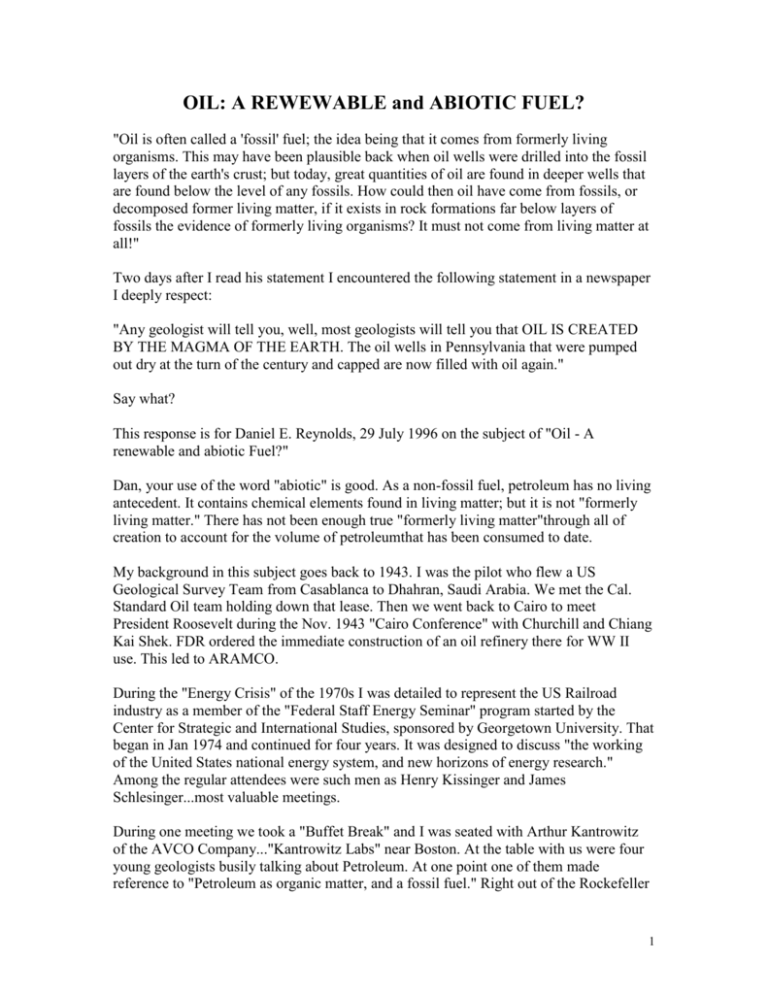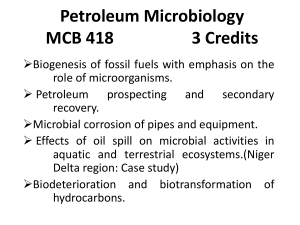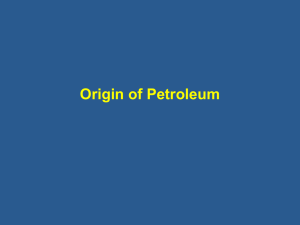OIL: A REWEWABLE and ABIOTIC FUEL
advertisement

OIL: A REWEWABLE and ABIOTIC FUEL? "Oil is often called a 'fossil' fuel; the idea being that it comes from formerly living organisms. This may have been plausible back when oil wells were drilled into the fossil layers of the earth's crust; but today, great quantities of oil are found in deeper wells that are found below the level of any fossils. How could then oil have come from fossils, or decomposed former living matter, if it exists in rock formations far below layers of fossils the evidence of formerly living organisms? It must not come from living matter at all!" Two days after I read his statement I encountered the following statement in a newspaper I deeply respect: "Any geologist will tell you, well, most geologists will tell you that OIL IS CREATED BY THE MAGMA OF THE EARTH. The oil wells in Pennsylvania that were pumped out dry at the turn of the century and capped are now filled with oil again." Say what? This response is for Daniel E. Reynolds, 29 July 1996 on the subject of "Oil - A renewable and abiotic Fuel?" Dan, your use of the word "abiotic" is good. As a non-fossil fuel, petroleum has no living antecedent. It contains chemical elements found in living matter; but it is not "formerly living matter." There has not been enough true "formerly living matter"through all of creation to account for the volume of petroleumthat has been consumed to date. My background in this subject goes back to 1943. I was the pilot who flew a US Geological Survey Team from Casablanca to Dhahran, Saudi Arabia. We met the Cal. Standard Oil team holding down that lease. Then we went back to Cairo to meet President Roosevelt during the Nov. 1943 "Cairo Conference" with Churchill and Chiang Kai Shek. FDR ordered the immediate construction of an oil refinery there for WW II use. This led to ARAMCO. During the "Energy Crisis" of the 1970s I was detailed to represent the US Railroad industry as a member of the "Federal Staff Energy Seminar" program started by the Center for Strategic and International Studies, sponsored by Georgetown University. That began in Jan 1974 and continued for four years. It was designed to discuss "the working of the United States national energy system, and new horizons of energy research." Among the regular attendees were such men as Henry Kissinger and James Schlesinger...most valuable meetings. During one meeting we took a "Buffet Break" and I was seated with Arthur Kantrowitz of the AVCO Company..."Kantrowitz Labs" near Boston. At the table with us were four young geologists busily talking about Petroleum. At one point one of them made reference to "Petroleum as organic matter, and a fossil fuel." Right out of the Rockefeller 1 bible. Kantrowitz turned to the geologist beside him and asked, "Do you really believe that petroleum is a fossil fuel?" The man said, "Certainly" and all four of them joined in. Kantrowitz listened quietly and then said, "The deepest fossil ever found has been at about 16,000 feet below sea level; yet we are getting oil from wells drilled to 30,000 and more. How could fossil fuel get down there? If it was once living matter, it had to be on the surface. If it did turn into petroleum, at or near the surface, how could it ever get to such depths? What is heavier Oil or Water?" Water: so it would go down, not oil. Oil would be on top, if it were "organic" and "lighter." "Oil is neither." They all agreed water was heavier, and therefore if there was some crack or other open area for this "Organic matter" to go deep into the magma of Earth, water would have to go first and oil would be left nearer the surface. This is reasonable. Even if we do agree that "magma" is a "crude mixture of minerals or organic matters, in a thin pasty state" this does not make it petroleum, and if it were petroleum it would have stayed near the surface as heavier items, i.e., water seeped below. My D. Van Nostrand "Scientific Encyclopedia" says "Magma is the term for molten material. A natural, complex, liquid, high temperature, silicate solution ancestral to all igneous rocks, both intrusive and effusive. The origin of Magma is not known." My "Oxford English Dictionary" does not even have the word "Magma." Some years ago I wrote two or three pages that appeared in the McGraw Hill Yearbook of Science and Technology, i.e., "Railroad Engineering." Even that source is a bit uncertain about the "origin of petroleum" to wit: "Less than 1% of the organic matter that originates in or is transported to the marine environment is eventually incorporated into ocean sediment," and "Most petroleum is formed during catagenesis (undefined anywhere). If sufficient organic matter is present oceanic sediments that undergo this process are potential petroleum sources. Deeply buried marine organic matter yields mainly oil, whereas land plant material yields mainly gas." (Their idea of "deeply buried" is the "out.") All this leaves us no where. I still go with Kantrowitz. Since oil is lighter than water, everywhere on Earth, there is no way that petroleum could be an organic, fossil fuel that is created on or near the surface, and penetrate Earth ahead of water. Oil must originate far below and gradually work its way up into well-depth areas accessible to surface drilling. It comes from far below. Therefore, petroleum is not a "Fossil" fuel with a surface or near surface origin. It was made to be thought a "Fossil" fuel by the Nineteenth oil producers to create the concept that it was of limited supply and therefore extremely valuable. This fits with the 2 "Depletion"allowance philosophical scam. During one of our C.S.I.S. "International Nights" (1978) the Common Market Energy boss, M. Montibrial of France, told us that while petroleum was being marketed then for $20.00 per barrel or more, it cost no more than 25 cents per barrel at the wellhead. There is our petroleum problem! We were paying more than $1.50-$1.60 per gallon, one 42nd of a barrel, at that time. Interested folks need to learn more about the Chartered Institute of Transport, and not waste their time with OPEC, the "Cover" story. Those who pumped the Pennsylvania wells "dry" during the late eighteen hundreds saved what they had for those better days. L. Fletcher Prouty Stimulated by Col. Prouty's assertion that OIL IS A NON-FOSSIL FUEL -- I put my roadster in high gear -- and went prospecting for some SOLID support! Well, I'm hear to tell you both, I DO BELIEVE I've FOUND IT - in spades! Item #1: A MAGNIFICENT BOOK!!!! TITLE: Power from the Earth Deep Earth Gas -- Energy for the Future by Thomas Gold [J.M. Dent & Sons, Ltd, London, 1987] ISBN 0-460-04462-1 May I quote a few lines from the front cover of the book ... a few words ... on JUST WHO THIS GUY THOMAS GOLD AND WHAT HE HAS TO SAY ON THIS SUBJECT! "Professor Thomas Gold is one of the great scientific thinkers of our time and in Power from the Earth he puts forward a highly revolutionary and controversial theory. According to Gold, there are within the Earth virtually limitless stores of energy in the form of gas and oil as yet untapped. This energy is of non-biological origin and there is far more of it in the Earth than geologists have ever imagined -- and IT IS ACCESSIBLE! --- Score 1 for Col. Prouty! At a time when the future supply of traditional fossil fuels is said to be seriously limited and nuclear energy is becoming ever more suspect, Gold's theory has vast implications for the future of the Earth's energy supplies and is crucial to our understanding of the deep processes that cause earthquakes and volcanoes. His view also clearly has far reaching consequences for the economic and political shape of the world. --- Score 2 for Col. Prouty! 3 In the past Professor Gold has explained the nature of pulsars and solar flares, proved that the Earth's poles change position over time, made new discoveries about the workings of the human inner ear, and was the only scientist to predict that Moon's surface consists of dust. His new theory has already been grabbing the attention of the international press and a drilling operation has been started in Sweden on the basis of his idea. In Power from the Earth Professor Gold puts forward one of the most important scientific ideas of our age." --- Well, having read the book, I can say I certainly concur with THAT OPINION. And guess what -- Dr. Gold is a friend of Arthur K. of AVCO LABS, etc....! BULLSEYE! --- Score 3 for Col. Prouty! WHO IS THIS MAN....well listen up... "Professor Thomas Gold, FRS, was born in Austria and educated in Switzerland and England, where he became famous as an astronomer at Cambridge in the postwar years. In 1956 he moved to the United States to become a professor at Harvard. He later became Professor of Astronomy at Cornell University, where he founded and directed the worldfamous Center for Radiophysics and Space Research. He is a Fellow of the Royal Society and of the United States National Academy of Sciences, and in 1985 was awarded the Gold Medal by the Royal Astronomical Scoiety. He now lives in Cambridge, England and is an Honorary Fellow of Trinity College." Not bad. Not bad at all. In fact, I'm honored to have made his acquaintance. ---- Score 4 for Col. Prouty & a Hearty THANK YOU TO DR. GOLD. They say -- he coined the term magnetosphere in '59! I wonder what HE THINKS is causing those black outs out West??? Falling tree limbs? Now THAT's an interesting hypothesis! Maybe a bird took out the TWA? Hey, it's just a theory, just a theory... OK ... now ... I hear some one murmuring ... "Well, if his Ideas are so good, so right, so profound -- SURELY THEY'VE MADE THE SCIENTIFIC LITERATURE ...REFEREED JOURNAL ARTICLES ... you know ... and all that. I mean ... if it's REEEEEEAL SCIENCE surely it's been recognized around the world!" As a matter of fact, it has! 4 My I introduce you both (if you have not been so introduced prior to this letter) to the work and writings of P.N. Kropotkin... Ref: Kropotkin, P. N. (1985) Degassing of the Earth and the Origin of Hydrocarbons, published in the International Geology Review, 27, 1261-1275 P.N. Kroptkin -- who is with the Geological Institute of the USSR Academy of Sciences, Moscow, it says in the header "has long been a leading proponent of the INORGANIC ORIGIN OF PETROLEUM, a THEORY which has had a continuous tradition of support in Russia and the Soviet Union and a recent revival in the United States and Western Europe." Oh, well, better late than never! THIS PAPER IS LOADED WITH FACTS! Anyone who thinks that Col. Prouty or Dr. Gold are spinning some kind of yarn ... HAD BEST READ IT -- ASAP. WE ARE BEING OFFERED AN IMMORTAL SYMPHONY BY THESE MEN -- and I for one LOVE the Sound of THIS MUSIC! May I share just one quote from the work of P.N. Kroptkin... from page 1265 ... just one of many, many AWESOME FACTS IN THIS SCIENTIFIC DOCUMENT... "Commercial oil pools in the basement rocks have been recorded in 267 oil and gas deposits on different continents. In some, oil is present at a depth of several hundred meters from its surface; in the USSR, such pools are known in a number of areas. A detailed analysis of the geological environment suggests that in some of these deposits, OIL COULD NOT HAVE ENTERED THE POOLS FROM THE OIL-BEARING STRATA OF THE SEDIMENTARY COVER AND, CONSEQUENTLY, PENETRATED FROM BELOW ALONG FAULTS. ---Score a HOME RUN for Col. Prouty and Dr. Gold!!!! Such is the Borolla deposit with pools in the Precambrian granites of the Shillong plateau (eastern India), the Peace River deposit in Western Canada associated with faults in the basin of the Athabasca River which border the zone of the pericratonic tough of the Canadian Shied, and the giganitc deposits of the Hugoton-Panhandle region of the USA and the Augila-Nafoora-Amal deposit in Libya. In the Hugoton-Panhandle deposit, the upper Paleozoic sediments and the basement rocks contain, in addition to oil, 2000 billion m^3 of fuel gases and 10 billion m^3 of helium and its concentration in such vast amounts over a small area may be explained, as earlier noted by V. I. Vernadskiy, solely by the migration of gas from a great depth, where faults drain huge volumes of rocks of the lithosphere." Petroleum Discussion Update for March 1997 FOSSIL-FUEL THEORY DEBUNKED: OIL, GAS DEPOSITS CALLED 5 PRIMORDIAL by Toledo Blade SEATTLE - The public's most widely known piece of geological knowledge--how petroleum and natural-gas deposits formed on Earth -- is false, a noted scientist says. Surprisingly, his campaign to rewrite school textbooks and encyclopedias is getting grudging support from some geologists, who acknowledge that petroleum's origins may be dramatically different from what people believe. Millions of Americans learned in grade school that oil deposits originated in the age of dinosaurs, when vegetation in lush forests was buried and subjected to high heat and pressure. Those extreme conditions supposedly transformed the hydrocarbons in vegetation into the hydrocarbons of petroleum. "That's nonsense," snapped Thomas Gold, a scientist at Cornell University. "There's not a shred of evidence from chemistry, geology, or any other science to support it. It has no place in textbooks and school classrooms." In appearances at the annual meeting of The American Association for the Advancement of Science in Seattle here that ended Thursday, Gold repeatedly challenged geologists to reconsider and reject the conventional theory. Gold also presented evidence that oil and gas deposits on Earth are primordial. That means they came with the planet. They were part of the original raw material that formed the sun and planets, and deposited deep below Earth's surface when the planet formed 4.5 billion years ago. Some of the oil gradually oozes upward from these original deposits 100 to 200 miles below the surface and collects where oil drillers can reach it. In one presentation, Gold described shafts that he and associates drilled in an ancient meteorite impact crater in Sweden. They drilled into a kind of rock that was not sedimentary, not associated with the sediments believed to produce oil deposits. At a depth of about 4 miles, they encountered a hydrocarbon oil similar to light petroleum that Gold believes was primordial oil. He noted a variety of evidence to support the belief. Gold estimated that this single site contained "more petroleum than all of Saudi Arabia." With current technology, however, pumping it out would be impossible, he added. Gold contended that many other planets and planetary bodies in the solar system have similar deep deposits of hydrocarbons, which are the stuff of oil and natural gas. Gold argues that a primordial origin for petroleum is the only way to explain its chemical composition. Petroleum originating from plant matter decayed by bacteria, similar to bacteria that decay backyard garden-compost piles, would resemble a microbial product. Instead, petroleum is chemically similar to a pure hydrocarbon that has been contaminated with microbial material. That contamination, he argues, occurred as petroleum seeped upward through rock now known to contain enormous amounts of bacterial life. In moving upward, petroleum also collected helium, explaining why oil wells are such a rich source 6 of helium. "This is the only possible explanation," Gold said. "The association of helium with petroleum has not been accounted for in any other way." How do geologists respond? They're beginning to listen, according to Michael Carr, who appeared on a panel where Gold presented his theory. Carr is a scientist with the US Geological Survey in Reston, Va. "Dr. Gold has some very, very good evidence, especially that involving helium," Carr said. "He certainly is challenging the geological community. There is a debate within the geological community." Carr said geologists plan to reconsider the conventional theory about petroleum formation at a major meting later in the year. Abiogenic petroleum origin From Wikipedia, the free encyclopedia. Abiogenic petroleum origin is a scientific hypothesis about the natural formation of petroleum. It states that petroleum is formed from non-biological sources of hydrocarbons located deep in the Earth's crust and mantle. This hypothesis is contrary to the more widely held view that petroleum is a fossil fuel -- produced from the remains of ancient living organisms. The constituent precursors of petroleum (mainly methane) are commonplace and it is possible that appropriate conditions exist for hydrocarbons to be formed deep within the Earth. "The capital fact to note is that petroleum was born in the depths of the Earth, and it is only there that we must seek its origin." (D. Mendeleev, 1877)[1] Although this theory is supported by a large minority of geologists in Russia, where it was intensively developed in the 1950s and 1960s, it has only recently begun to receive attention in the West, where the biogenic petroleum theory is still believed by the vast majority of petroleum geologists. Planetary scientist Thomas Gold was one of the abiogenic theory's greatest proponents in recent years.[2] Although it was originally denied that abiogenic hydrocarbons exist at all on earth, this is now accepted by Western geologists. The orthodox and widely accepted position now is that while abiogenic hydrocarbons exist (in inverse proportion to hydrocarbon chain complexity), they are not produced in commercially significant quantities. The modern Russian-Ukrainian theory of petroleum, based on thermodynamic calculations made for the first time by Ukrainian scientist, Prof. Emmanuil B. Chekaliuk (1967), contends that petroleum is formed at high pressure and temperature in the earth's mantle, out of carbon that has never been part of a living thing. This theory is said to be supported by experimental studies conducted by Dr J.F. Kenney and his Russian colleagues. Their conclusions about petroleum origin are also said to vindicate the theories propounded by the geologist Nikolai Kudryavtsev. 7 A variation of the abiogenic theory includes alteration by microbes similar to those which form the basis of the ecology around deep hydrothermal vents. One prediction of most abiogenic theories is that other planets of the solar system or their moons have large petroleum oceans, either from hydrocarbons present at the formation of the solar system, or subsequent chemical reactions. One indication that this theory is receiving increasing attention from Western geologists is indicated by the conference of the American Association of Petroleum Geologists scheduled for July 2004 in Vienna, entitled "Origin of Petroleum—Biogenic and/or Abiogenic and Its Significance in Hydrocarbon Exploration and Production". Financial considerations, however, caused it to be cancelled. Instead, AAPG held a one-day session on the topic at the June 2005 annual meeting in Calgary, Alberta.[3] Comparison of theories There are two theories on the origin of carbon fuels: the biogenic theory and the abiogenic theory. The two theories have been intensely debated since the 1860s, shortly after the discovery of widespread petroleum deposits. There are several crucial differences between the biogenic and abiogenic theories. Raw material Biogenic: remnants of buried plant and animal life. Abiogenic: deep carbon deposits from when the planet formed or subducted material. Events before conversion Biogenic: Organic matter consisting of dead plants and animals is deposited and buried. Accumulating sediments compress the material over geologic time scales. At a depth of several hundred meters, heat and pressure convert it to bitumens and kerogens. Abiogenic: At depths of hundreds of kilometers, carbon deposits are a mixture of hydrocarbon molecules which migrate upward through the crust. Much of the material becomes methane. Conversion to petroleum and methane Biogenic: Time, temperature, and pressure crack kerogens into the hydrocarbons that comprise petroleum in a process called catagenesis. Abiogenic: When the material passes through temperatures at which extremophile microbes can survive some of it will be consumed and converted to heavier hydrocarbons. Another formulation of abiogenic origin theory sees microbial life strictly as a contaminant, unnecessary to account for any "biomarkers" supposedly supporting biogenic origins.[4] The full suite of hydrocarbons found in petroleum is generated at depth by abiogenic processes,[5] and therefore shallow petroleum deposits represent the simple displacement of those hydrocarbons from their formation environment. 8 Formation of coal Biogenic: Coal is organic material which was buried and compressed but did not undergo catagenesis into kerogens. Abiogenic: Coal is organic material which was filled with hydrocarbons which seeped into the deposit. This can happen on the surface, such as in a swamp with methane and petroleum seeps. Evidence supporting abiogenic theory Supergiant oil fields Russian geologist Nikolai Alexandrovitch Kudryavtsev was the first to propose the modern abiotic theory of petroleum. He studied the Athabasca Tar Sands in Alberta, Canada and concluded that no "source rocks" could form the enormous volume of hydrocarbons, and that therefore the most plausible explanation is abiotic deep petroleum. Kudryavtsev was also a prominent and forceful advocate of the abiogenic theory. He argued that no petroleum resembling the chemical composition of natural crudes has ever been made from plant material in the laboratory under conditions resembling those in nature. He gave many examples of substantial and sometimes commercial quantities of petroleum being found in crystalline or metamorphic basements, or in sediments directly overlying those. He cited cases in Kansas, California, Western Venezuela and Morocco. He also pointed out that oil pools in sedimentary strata are often related to fractures in the basement directly below. This is evidenced by the Ghawar supergiant oil field (Saudi Arabia); the Panhandle Field in Kansas (United States), which also produces helium; the Tengiz Field (Kazakhstan); the White Tiger Field (Vietnam); and innumerable others. The Lost Soldier Field in Wyoming has oil pools, he stated, at every horizon of the geological section, from the Cambrian sandstone overlying the basement to the upper Cretaceous deposits. A flow of oil was also obtained from the basement itself. Hydrocarbon gases, he noted, are not rare in igneous and metamorphic rocks of the Canadian Shield. Petroleum in Precambrian gneiss is encountered in wells on the eastern shore of Lake Baikal. He stressed that petroleum is present, in large or small quantity, but in all horizons below any petroleum accumulation, apparently totally independent of the varied conditions of formation of these horizons. This statement has since become known as "Kudryavtsev's Rule" and many examples of it have been noted in different parts of the world. He concluded that commercial accumulations are simply found where permeable zones are overlaid by impermeable ones. Kudryavtsev introduced a number of other relevant considerations into the argument. Columns of flames have been seen during the eruptions of some volcanoes, sometimes reaching 500 meters in height, such as during the eruption of Merapi in Sumatra in 1932. (There have been several other instances subsequently.) The eruptions of mud-volcanoes have liberated such large quantities of methane that even the most prolific gasfield underneath should have been exhausted long ago. Also the quantities of mud deposited in some cases would have required eruptions of much more gas than is known in any 9 gasfield anywhere. The water coming up in some instances carries such substances as iodine, bromine and boron that could not have been derived from local sediments, and that exceed the concentrations in seawater one hundred fold. Mud volcanoes are often associated with lava volcanoes, and the typical relationship is that where they are close, the mud volcanoes emit incombustible gases, while the ones further away emit methane. He knew of the occurrence of oil in basement rocks of the Kola Peninsula, and of the surface seeps of oil in the Siljan Ring formation of Central Sweden. He noted as mentioned above that the enormous quantities of hydrocarbons in the Athabasca tar sands in Canada would have required vast amounts of source rocks for their generation in the conventional discussion, when in fact no source rocks have been found. Existence of hydrocarbon deposits The world’s conventional oil reserves should disappear in no more than one million years, based upon the rate of hydrocarbon seepages.[6] If there is a limited source of hydrocarbon deposits, in geologic time frames, it is an extraordinary coincidence that deposits exist now. If such deposits are being replenished, their existence becomes less surprising. This is a somewhat misleading argument, however. We see evidence of fossil tar pits over a wide range of periods and indeed many of them are important sources of fossils. This indeed proves replenishment, but one which biogenic origin can easily explain. Indeed, abiogenic origin has a hard time explaining why hydrocarbon deposits are not far more widespread than they are as any significant abiogenic source would be quite markedly very large scale. The likes of earthquakes would cause catastrophic 'oil slicks' in oceans, for example, by rupturing impervious cap rocks. Extraterrestrial methane Methane and many other hydrocarbons have been detected at several locations throughout the solar system. Methane is a common component in the makeup of the cosmos, and was likely incorporated into the Earth during formation. Alternatively, it may be delivered to Earth in abundance by chondrite meteorites. Extraterrestrial methane is apparently created by abiogenic processes, except possibly on Mars, where extraterrestrial biology may be involved. Thomas Gold's formulation of the abiogenic thoery of petroleum origin requires primordial methane from the Earth's formation or early history. However, new experiments demonstrate that hydrocarbons will be generated spontaneously from other carbon sources, such as calcium carbonate, at pressures found in the Earth's mantle. Extrarrestrial methane has been detected on or in: Jupiter Neptune Oberon Mars Triton Titania Saturn Uranus Umbriel Iapetus Ariel Pluto Titan Miranda Comet Halley Comet Hyakutake Interstellar gas and cosmic dust 10 In 2004, the Cassini spacecraft confirmed a hydrocarbon weather system on Titan. It should be noted, however, that the Titanian hydrocarbon system is a photocatalyzed methane/ethane equilibrium of a kind which cannot exist in Earth's oxygen-rich atmosphere. Cold planetary formation In the late 19th century it was believed that the Earth was extremely hot, possibly completely molten, during its formation. One reason for this was that a cooling, shrinking, planet was necessary in order to explain geologic changes such as mountain formation. A hot planet would have caused methane and other hydrocarbons to be outgassed and oxidized into carbon dioxide and water, thus there would be no carbon remaining under the surface. Many planetary scientists now believe that formation was a relatively cool process until radioactive materials accumulated together deep in the planet. Recent testing of a zircon, at 4.4 billion years old the world's oldest rock, suggests rocks which formed at temperatures low enough for liquid water. The Moon formed only shortly before this time. [7] Unusual deposits Hydrocarbon deposits have been found in places that are said to be poorly explained by biogenic theory. Some oil fields are being refilled from deep sources, although this does not rule out a deep biogenic source rock. In the White Tiger field in Vietnam and many wells in Russia, oil and natural gas are being produced from reservoirs in granite basement rock. In the Vietnamese case, this rock is believed to have no oil-producing sediments under it, so the biogenic theory requires the oil to have migrated laterally dozens of kilometers along faults from source rock. Deep microbes Microbial life has been discovered 4.2 kilometers deep in Alaska and 5.2 kilometers deep in Sweden. Methanophile organisms have been known for some time, and recently it was found that microbial life in Yellowstone National Park is based on hydrogen metabolism. Other deep and hot extremophile organisms continue to be discovered. Proponents of abiogenic petroleum origin contend that deep microbial life is responsible for the biomarkers (see below) that are generally cited as evidence of biogenic origin. U.S. Geological Survey (USGS) scientist Frank Chapelle and his colleagues from the USGS and the University of Massachusetts have discovered a potential analog for life on other planets. A community of Archaea is thriving deep in the subsurface source of a hot spring in Idaho. Geothermal hydrogen, not organic carbon, is the primary energy source for this methanogen-dominated microbial community. This is the first documented case of a microbial community completely dominated by Archaea.[8] Helium Helium gas has close association with petroleum. Although ³He is primordial, much He gas is from radioactive decay of uranium. Helium gas is associated with light oils, 11 sometimes accompanied by nitrogen that allow petroleum to reach shallow levels in crust. Hydrogen Petroleum is composed mainly of n-alkanes. Sir Robert Robinson, Nobel Laureate in chemistry, studied the chemical make-up of natural petroleums in great detail, and concluded that they were mostly far too hydrogen-rich to be a likely product of the decay of plant debris. Olefins (n-alkenes), the unsaturated hydrocarbons, would have been expected to predominate by far in any material that was derived in that way. He also wrote: "Petroleum ... [seems to be] a primordial hydrocarbon mixture into which bioproducts have been added." Trace metals Nickel (Ni),vanadium (V),lead (Pb),arsenic (As),cadmium (Cd),mercury (Hg) and others metals frequently occur in oils. Some heavy crude oils, such as Venezuelan heavy crude have up to 45% vanadium pentoxide content in their ash, high enough that it is a commercial souce for vanadium. These metals are common in earth's mantle that is why their compounds in oils are often called as abiomarkers. Analysis of 22 trace elements in 77 oils correlate significantly better with chondrite, serpentinized fertile mantle peridotite, and the primitive mantle than with oceanic or continental crust, and shows no correlation with seawater. [9] Diamondoids Tiny diamondoids occur in oils and condensates. They have similar diamond structure and suspected to have similar origins related to kimberlite diamond deposits, from hot and high pressure rocks in the earth´s mantle. Thermodynamics The Second Law of Thermodynamics prohibits spontaneous generation of hydrocarbons heavier than methane at low pressures. Thermodynamic calculations and experimental studies confirm that n-alkanes (common petroleum components) do not spontaneously evolve from methane at pressures typically found in sedimentary basins, and so the theory of an abiogenic origin of hydrocarbons suggests deep generation (below 200 km [10].) Biology Life as we know it is mainly based on carbon. First living organisms (archaeobacteria) of course needed food and this food at least was primordial methane or petroleum (hydrocarbons) in depths. They live at deep levels in crust and they formed oil contaminants which also became parts of biomarkers found in natural petroleum. Photosynthesis is a very complicated process that primitive organisms got to achieve the surface of our planet, probably this situation occurred with its evolution seeking for food when hydrocarbon upwelling locally ceased, then as said by Astrophysicist Thomas Gold, primitive bacteria invented photosynthesis making your own food, i.e. autotrophs. 12 Serpentinization and chemical synthesis of oil Deep sea vent biogeochemical cycle diagramAnother possible formation of inorganic oil is via Fischer-Tropsch Synthesis. The Fischer-Tropsch process converts carbon dioxide, carbon monoxide, and methane into liquid hydrocarbons of various forms. The carbon dioxide and carbon monoxide is generated by partial oxidation of coal and wood-based fuels. This process was developed and used extensively in World War II by Germany, which had limited access to crude oil supplies. It is today used in South Africa to produce most of that country's diesel from coal. Since there are large but finite coal reserves in the world, this technology could be used as an interim transportation fuel if conventional oil were to disappear. There are several companies developing the process to enable practical exploitation of so-called stranded gas reserves, those reserves which are impractical to exploit with conventional gas pipelines and LNG technology. Serpentinization of carbon-rich peridotite ultramafic rocks involving Fischer-Tropsch reactions are thought to occur within the crust of the earth when mantle peridotite is hydrolysed becoming serpentinite while releasing hydrogen. In the presence of catalyst transition metals (e.g. Fe, Ni) hydrogen reacts with carbon dioxide from carbonate rocks and results in n-alkane hydrocarbons, including linear saturated hydrocarbons, alcohols, aldehydes, ketones, aromatics, and cyclic compounds.[11] Nanodiamonds in mineral fuels suggest contact with material with such a deep hot history. Where hydrocarbon fluids encounter shelf limestones, extensive replacement reactions occur which form large volumes of hydrothermal dolomite.[12] Deep structures and petroleum association Oil and gas fields are mainly found over deep, fractured basement structures in the earth such as plate boundaries and meteorite impact craters. This association can be observed in the distribuition of oil fields along the arcs, for instance, of Indonesia, the Persian Gulf, the Apennines in Italy, Alaska, and the Barbados Arc continuing towards Trinidad & Tobago and Venezuela. Why is oil frequently found in sedimentary basins? Sedimentary basins fill and cover depression areas where occurred deep faults associated with plate limits (rifts, convergent subduction or collision between two plates) and sedimentary strata form good reservoirs (pore spaces) and seals that trap hydrocarbons and these reservoirs are connected to deep sources through deep faults. Petroleum also occurs in the crystalline basement, though large accumulations are rare. Hydrocarbons rise from great depth due to their buoyancy, accumulating when they encounter impermeable caprock such as shale. These accumulations within porous strata are the most economical places to mine petroleum. Traditional biogenic theory also predicts such accumulations in sedimentary strata (as a formation environment), so a confirmation bias may have developed in the oil exploration industry. 13 Most fluid motion within rock occurs along fractures, so hydrocarbons preferentially rise through the deep fracture networks associated with plate boundaries, because these mega structures reach earth's mantle. Ambiguous results Ongoing research has changed the status of some information. For example, some biomarkers which were interpreted as evidence supporting the biogenic theory have been undermined by finding similar materials in thermophilic situations which are part of abiogenic theories. Biomarkers or Chemofossils Chemicals of biological origin have been found in many geologic hydrocarbon deposits. These biomarkers were believed to be from known surface sources. Due to the difficulty in culturing and sampling deep heat-loving bacteria, thermophiles, little was known of their chemistry. As more is learned of bacterial chemistry, more biomarkers seem likely to be due to bacterial action. Hopanoids, called the 'most abundant natural products on Earth', were believed to be indicators of oil derived from ferns and lichens but are now known to be created by many bacteria, including archaea. Sterane was thought to have come from processes involving surface deposits but is now known to be produced by several prokaryotes including methanotrophic proteobacteria. Thorough rebuttal of biogenic origins based on biomarkers has been offered by Kenney, et al. (2001).[4] A general summary of commonly cited biomarkers follows. Claims that the presense of such biomarkers in petroleum indicates biogenic origin may be found in most modern, english-language textbooks on petroleum. Organic compounds Biogenic: Rare organic compounds found in both petroleum and biological matter illustrate that the former comes from the latter. These include terpenoids, terpenes, pristane, phytane, cholestane, and most impressively, chlorins and porphyrins, which are large, chelating molecules in the same family as heme and chlorophyll. Abiogenic: Each of the chemicals has been observed in carbonaceous chondrite meteorites, immediately disproving any biological association. Cholestane is very similar to the biological chemical cholesterol, however, the latter has never been found in petroleum. Porphyrins, in particular, were observed in the Orgueil meteorite as early as 1964,[13] and produced by abiogenic means mimicking the Earth in 1967.[14] Furthermore, the chelated metal element is always magnesium in chlorophyll, and iron in heme. Porphyrins found in petroleum are usually chelated with vanadium or nickel.[4] Odd-number carbon abundance Biogenic: Members of the n-alkane series found in petroleum have a slighlty greater abundance of odd-numbered carbon chains (propane, pentane, etc.) Likewise, linear carbohydrate molecules in living systems exhibit the same preference for odd carbon numbers. In the biogenic framework, the former seems to come from the latter. 14 Abiogenic: All populations of linear hydrocarbon chains, be they artificial, natural, or biological, exhibit this tendency. It arises from the geometry of the covalent bond in linear molecules. Chirality Biogenic: The presense of optical activity in petroleum indicates biological origin, because biological compounds are known to exhibit left-handed chirality. Abiogenic: The idea that optical activity implies biology is a relic dating from the founding work of Louis Pasteur, who first explained the polarization of light in wine in terms of chirality. The study of stereochemistry has revealed that many natural systems, including hydrocarbons in primordial meteorites, possess an imbalance of chirality that results in optical activity. Petroleum may have right- or left-handed optical activity, which contrasts with biological systems' exclusive left-handed chirality. This distinction has led to chirality being regarded as an abiomarker among proponents of the abiogenic theory. Deep hot carbon sources Carbonate lava Carbonatites are intrusive carbonate-mineral-rich igneous rocks. Although they are deposits of carbon from an igneous source, the geology behind their creation is not understood. Hydrothermal vents Hydrothermal vents expel mineral-rich geothermally heated water. Carbon dioxide abiogenically produced from magma: As magma outgasses helium and carbon dioxide at depths less than 60 km, there should be deep carbon fluids present in areas such as oceanic ridges where the magma is able to heat surface waters. Microbes can create methane: Extremophile methanogens such as Methanopyrus can convert CO2 to methane. Methane can also be created chemically: Iron in rock can release hydrogen from water, then carbon dioxide can combine with the hydrogen to produce methane and water. University of Minnesota researchers discovered that rocks rich in chromium minerals can encourage chemical methane production, while also producing the more complex hydrocarbons ethane and propane. Methane and carbon dioxide may be dissolved in water which enters hydrothermal vent systems. Hydrothermal vents might release methane and carbon from deposits of biological origin, although this is less likely in vents at spreading oceanic ridges. Evidence supporting biogenic theory 15 Unusual deposits While it is true that some oil fields do not conform to the standard model of a fixed amount of oil trapped in a sedimentary basin, these examples are accommodated by the biogenic model. For example, the White Tiger field (Cuu Long Basin) cited above is located in an area where significant normal faulting brings relatively young sedimentary rocks into contact with older, fractured horst blocks of igneous rocks.[15] The produced oil is described as typically lacustrine (derived from lake deposits), consistent with the migration of hydrocarbons from the organic-rich sediments into the fractured basement. In Eugene Island 330, a large production area of that is currently being recharged, a deep source rock is indicated, and the chemical composition of the recharging oil strongly indicates that it is leaking from a deep, intermediate reservoir. US continuous hydrocarbon reservoirs.One type of unusual deposit that one might to expect to find if the abiogenic hypothesis is true would be hydrocarbons trapped in sedimentary basins that do not contain conventional source rocks. Evidence for such deposits is lacking. Many economically disappointing wells have been drilled into geologic structures that would be expected to trap hydrocarbons, but there are no hydrocarbons present. Oil companies have learned that an appropriate source rock is necessary before they will commit to drilling a well in a potential new field. Biomarkers It has been argued that the abiogenic theory does not explain the detection of various biomarkers in petroleum. Microbial consumption does not yet explain some trace chemicals found in deposits. Materials which suggest certain biological processes include tetracyclic diterpane and oleanane. Although extremophile microorganisms exist deep underground and some metabolize carbon, some of these biomarkers are only known so far to be created in surface plants. This evidence is consistent with the biogenic hypothesis, although it might be true that these hydrocarbons have merely been in contact with ancient plant residues. There also is evidence that low-temperature relatives of hyperthermophiles are widespread, so it is also possible for biological deposits to have been altered by low-temperature bacteria which are similar to deeper heat-loving relatives. One study found diamondoids in oil show high levels of carbon isotopic fractionation the same as most true biomarkers, indicating diamondoid derivation from enzymatically-created lipids.[16] Petroleum origin, peak oil, and politics Many aspects of the abiogenic theory were developed in the former Soviet Union by Russian and Ukrainian scientists during the Cold War. Some proponents see a proWestern bias in the promotion of the biogenic theory. Thus, in addition to the scientific merits of competing hypothoses, political and economic considerations often influence discussions of petroleum origins. The topic of the origin of petroleum is also linked to discussions of projected declines in petroleum production, variously referred to as "peak oil" or "Hubbert's peak". Some environmentalists accuse abiogenic theory supporters of a "cornucopian" worldview. 16 They claim that such a view incorrectly sees no limits to exploitation of petroleum supplies while simultaneously ignoring potential consequences of petroleum consumption such as global warming. Conversely, some supporters of the abiogenic theory accuse their opponents of an unwarranted Malthusian viewpoint that needlessly limits the use of hydrocarbons as an energy source and artificially inflates oil prices. Independent of whether massive hydrocarbon reserves exist deep in the crust, they are unattainable in the short term. Considering the apparent dominance of the biogenic origin theory in the exploration industry, new oil discoveries based on abiogenic theory may be slow in coming. The ASPO predicts that global oil production will peak in 2007, while some other organizations such as the USGS pick as late as 20 years later. Whenever it may happen, it is unlikely that the serious economic ramifications of peak oil can be avoided. For this reason, as well as concerns about global warming, development of nuclear power and renewable energy sources continues at an accelerating pace. These aspects of the controversy may be seen in many of the online articles in the External links section below. The future of the abiogenic theory Apart from the Russian interest, active proponents of the abiogenic theory in the west have all but disappeared. Thomas Gold died in 2004, with apparently none of his students following up on his research. Conspiracist Joe Vialls [17] died in 2005. The passing of the torch may go to Dr. Jerome R. Corsi, author of "Black Gold Stranglehold", or Dr. Jack Kenney of Gas Resources Corporation[18](see references). Nevertheless, the theory has received continued attention in the media and scientific organizations (note external links). One day of AAPG's 2005 conference was devoted to the subject, indicating serious professional interest [19]. The results of the Cassini-Huygens mission to Titan (a moon of Saturn) indicated the existence of hydrocarbons, mainly methane. This can be interpreted as support for an abiogenic petroleum origin on a cool early Earth. Studies of ocean floor hydrothermal vents as in the Lost City hydrothermal field; mud volcanoes; mantle peridotite serpentinization; hydrocarbons in meteorites; experimental studies of abiogenic methane generation; reworking primordial hydrocarbons by bacteria; the association of the gases helium and nitrogen in many oil fields; and the presence of trace metals related to Earth's mantle (Ni, V, Cd, As, Pb, Zn, Hg and others); will permit a better understanding of the origin of natural hydrocarbons in the Earth. See also Fischer-Tropsch process Petroleum Peak oil Mineral fuel, also known as Fossil fuel Thomas Gold [edit] References 17 ^ Mendeleev, D., 1877. L'origine du petrole. Revue Scientifique, 2e Ser., VIII, p. 409416. ^ Gold, Thomas (1999). The deep, hot biosphere, Copernicus Books. ISBN 0387985468 ^ "AAPG Research Conference, June 18, 2005, Calgary, Alberta, Canada; #90043 (2005)." Accessed September 9, 2005. ^ a Kenney, J., Shnyukov, A., Krayushkin, V., Karpov, I., Kutcherov, V. and Plotnikova, I. (2001). Dismissal of the claims of a biological connection for natural petroleum. Energia 22: 26-34. Article link ^ Kenney, J., Kutcherov, V., Bendeliani, N. and Alekseev, V. (2002). The evolution of multicomponent systems at high pressures: VI. The thermodynamic stability of the hydrogen–carbon system: The genesis of hydrocarbons and the origin of petroleum. Proceedings of the National Academy of Sciences 99: 10976-10981. Article link ^ Kitchka, A., Juvenile Petroleum Pathway: From Fluid Inclusions via Tectonic Pathways to Oil Fields. AAPG Research Conference, Calgary, Canada, 2005. Article link ^ John W. Valley, William H. Peck, Elizabeth M.King, Simon A. Wilde (2002). A Cool Early Earth. Geology 30: 351-354. "A Cool Early Earth". Zircons Are Forever. URL accessed on April 11, 2005. ^ Chapelle, F.H., O'Neill, K., Bradley, P.M., Methe, B.A., Ciufo, S.A., Knobel, L.L., and Lovley, D.R. (2002). A hydrogen-based subsurface microbial community dominated by methanogens. Nature 415: 312-315. DOI:10.1038/415312a ^ Szatmari1, P, Da Fonseca, T, and Miekeley, N. Trace Element Evidence for Major Contribution to Commercial Oils by Serpentinizing Mantle Peridotites. AAPG Research Conference, Calgary, Canada, 2005.Article link ^ "The Prohibition of Hydrocarbon Genesis at Low Pressures". Gas Resources Corporation. URL accessed on April 15, 2005. ^ "http://www.searchanddiscovery.net/documents/abstracts/2005research_calgary/abstracts /short/charlou.htm." Accessed September 9, 2005. ^ Hodgson, G. and Baker, B. (1964). Evidence for porphyrins in the Orgueil meteorite. Nature 202: 125-131. ^ Hodgson, G. and Baker, B. (1964). Porphyrin abiogenesis from pyrole and formaldehyde under simulated geochemical conditions. Nature 216: 29-32. ^ "Hydrothermal Hydrocarbons, by Stanley B. Keith and Monte M. Swan; #90043 (2005)." Accessed September 9, 2005. ^ Brown, David (2005). Vietnam finds oil in the basement AAPG Explorer 26 (2): 8-11. Article link ^ "Petroleum: To Be Or Not To Be Abiogenic, by M. R. Mello and J. M. Moldowan; #90043 (2005)." Accessed September 9, 2005. ^ "Joe Vialls, Private Investigator, Exposing Media Disinformation." Accessed September 9, 2005. ^ "Gas Resources Corporation." Accessed September 9, 2005. ^ "AAPG Research Conference, June 18, 2005, Calgary, Alberta, Canada; #90043 (2005) (See above)." Accessed September 9, 2005. Com m entary World Net Daily 18 Sustainable oil? Posted: May 25, 2004 1:00 a.m. Eastern By Chris Bennett © 2004 WorldNetDaily.com About 80 miles off of the coast of Louisiana lies a mostly submerged mountain, the top of which is known as Eugene Island. The portion underwater is an eerie-looking, sloping tower jutting up from the depths of the Gulf of Mexico, with deep fissures and perpendicular faults which spontaneously spew natural gas. A significant reservoir of crude oil was discovered nearby in the late '60s, and by 1970, a platform named Eugene 330 was busily producing about 15,000 barrels a day of high-quality crude oil. By the late '80s, the platform's production had slipped to less than 4,000 barrels per day, and was considered pumped out. Done. Suddenly, in 1990, production soared back to 15,000 barrels a day, and the reserves which had been estimated at 60 million barrels in the '70s, were recalculated at 400 million barrels. Interestingly, the measured geological age of the new oil was quantifiably different than the oil pumped in the '70s. Analysis of seismic recordings revealed the presence of a "deep fault" at the base of the Eugene Island reservoir which was gushing up a river of oil from some deeper and previously unknown source. Similar results were seen at other Gulf of Mexico oil wells. Similar results were found in the Cook Inlet oil fields in Alaska. Similar results were found in oil fields in Uzbekistan. Similarly in the Middle East, where oil exploration and extraction have been underway for at least the last 20 years, known reserves have doubled. Currently there are somewhere in the neighborhood of 680 billion barrels of Middle East reserve oil. Creating that much oil would take a big pile of dead dinosaurs and fermenting prehistoric plants. Could there be another source for crude oil? An intriguing theory now permeating oil company research staffs suggests that crude oil may actually be a natural inorganic product, not a stepchild of unfathomable time and organic degradation. The theory suggests there may be huge, yet-to-be-discovered reserves of oil at depths that dwarf current world estimates. The theory is simple: Crude oil forms as a natural inorganic process which occurs between the mantle and the crust, somewhere between 5 and 20 miles deep. The proposed mechanism is as follows: Methane (CH4) is a common molecule found in quantity throughout our solar system – huge concentrations exist at great depth in the Earth. At the mantle-crust interface, roughly 20,000 feet beneath the surface, rapidly rising streams of compressed methane-based gasses hit pockets of high 19 temperature causing the condensation of heavier hydrocarbons. The product of this condensation is commonly known as crude oil. Some compressed methane-based gasses migrate into pockets and reservoirs we extract as "natural gas." In the geologically "cooler," more tectonically stable regions around the globe, the crude oil pools into reservoirs. In the "hotter," more volcanic and tectonically active areas, the oil and natural gas continue to condense and eventually to oxidize, producing carbon dioxide and steam, which exits from active volcanoes. Periodically, depending on variations of geology and Earth movement, oil seeps to the surface in quantity, creating the vast oil-sand deposits of Canada and Venezuela, or the continual seeps found beneath the Gulf of Mexico and Uzbekistan. Periodically, depending on variations of geology, the vast, deep pools of oil break free and replenish existing known reserves of oil. There are a number of observations across the oil-producing regions of the globe that support this theory, and the list of proponents begins with Mendelev (who created the periodic table of elements) and includes Dr. Thomas Gold (founding director of Cornell University Center for Radiophysics and Space Research) and Dr. J.F. Kenney of Gas Resources Corporations, Houston, Texas. In his 1999 book, "The Deep Hot Biosphere," Dr. Gold presents compelling evidence for inorganic oil formation. He notes that geologic structures where oil is found all correspond to "deep earth" formations, not the haphazard depositions we find with sedimentary rock, associated fossils or even current surface life. He also notes that oil extracted from varying depths from the same oil field have the same chemistry – oil chemistry does not vary as fossils vary with increasing depth. Also interesting is the fact that oil is found in huge quantities among geographic formations where assays of prehistoric life are not sufficient to produce the existing reservoirs of oil. Where then did it come from? Another interesting fact is that every oil field throughout the world has outgassing helium. Helium is so often present in oil fields that helium detectors are used as oilprospecting tools. Helium is an inert gas known to be a fundamental product of the radiological decay or uranium and thorium, identified in quantity at great depths below the surface of the earth, 200 and more miles below. It is not found in meaningful quantities in areas that are not producing methane, oil or natural gas. It is not a member of the dozen or so common elements associated with life. It is found throughout the solar system as a thoroughly inorganic product. Even more intriguing is evidence that several oil reservoirs around the globe are refilling themselves, such as the Eugene Island reservoir – not from the sides, as would be expected from cocurrent organic reservoirs, but from the bottom up. 20 Dr. Gold strongly believes that oil is a "renewable, primordial soup continually manufactured by the Earth under ultrahot conditions and tremendous pressures. As this substance migrates toward the surface, it is attached by bacteria, making it appear to have an organic origin dating back to the dinosaurs." Smaller oil companies and innovative teams are using this theory to justify deep oil drilling in Alaska and the Gulf of Mexico, among other locations, with some success. Dr. Kenney is on record predicting that parts of Siberia contain a deep reservoir of oil equal to or exceeding that already discovered in the Middle East. Could this be true? In August 2002, in the "Proceedings of the National Academy of Sciences (US)," Dr. Kenney published a paper, which had a partial title of "The genesis of hydrocarbons and the origin of petroleum." Dr. Kenney and three Russian coauthors conclude: The Hydrogen-Carbon system does not spontaneously evolve hydrocarbons at pressures less than 30 Kbar, even in the most favorable environment. The H-C system evolves hydrocarbons under pressures found in the mantle of the Earth and at temperatures consistent with that environment. He was quoted as stating that "competent physicists, chemists, chemical engineers and men knowledgeable of thermodynamics have known that natural petroleum does not evolve from biological materials since the last quarter of the 19th century." Deeply entrenched in our culture is the belief that at some point in the relatively near future we will see the last working pump on the last functioning oil well screech and rattle, and that will be that. The end of the Age of Oil. And unless we find another source of cheap energy, the world will rapidly become a much darker and dangerous place. If Dr. Gold and Dr. Kenney are correct, this "the end of the world as we know it" scenario simply won't happen. Think about it ... while not inexhaustible, deep Earth reserves of inorganic crude oil and commercially feasible extraction would provide the world with generations of low-cost fuel. Dr. Gold has been quoted saying that current worldwide reserves of crude oil could be off by a factor of over 100. A Hedberg Conference, sponsored by the American Association of Petroleum Geologists, was scheduled to discuss and publicly debate this issue. Papers were solicited from interested academics and professionals. The conference was scheduled to begin June 9, 2003, but was canceled at the last minute. A new date has yet to be set. Related links: Gas Origin Theories To Be Studied The Mystery Of Eugene Island 330 Odd Reservoir Off Louisiana Prods Oil Experts To Seek A Deeper Meaning Fuel's Paradise 21 Chris Bennett manages an environmental engineering division for a West Coast technology firm. He and his wife of 26 years make their home on the San Francisco Bay. 22









